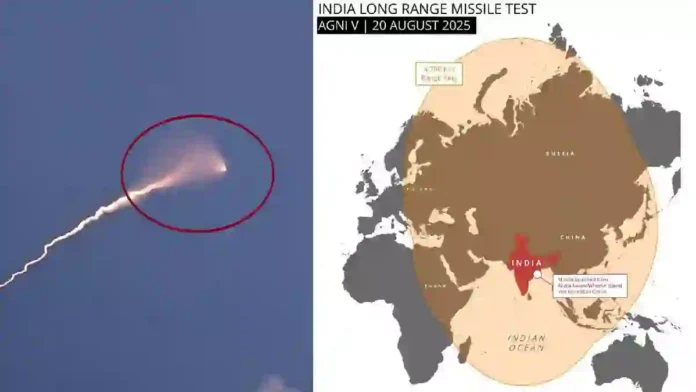India’s successful test-firing of the Agni-5 long-range ballistic missile from the Integrated Test Range at Chandipur, Odisha, marks a pivotal milestone in the nation’s strategic defence progression.
The test, conducted on 20 August 2025, validated all operational and technical parameters as confirmed by the Ministry of Defence, underscoring India’s growing capabilities in advanced ballistic missile technology.
Read- ARDE Reportedly Developing Advanced Gatling Gun System For The Indian Army And Air Force
The Agni-5, developed by the Defence Research and Development Organisation (DRDO), stands as the most sophisticated missile in the Agni series, forming the backbone of India’s land-based nuclear deterrent.
With a striking range exceeding 5,000km, Agni-5 is nuclear-capable and engineered to deliver a warhead weighing up to 1.5 tonnes, leveraging lightweight composite materials which heighten both reliability and efficiency.
A hallmark feature of the Agni-5 missile is its integration of Multiple Independently Targetable Re-entry Vehicle (MIRV) technology. This advancement empowers a single missile to deliver multiple warheads on distinct targets, greatly multiplying the strategic effectiveness and survivability of India’s deterrent arsenal.
For guidance and targeting precision, the Agni-5 employs state-of-the-art ring laser gyroscope-based inertial navigation system (RLG-INS), supplemented by a micro-inertial navigation system (MINGS).
Read- Russia Offers 5% Oil Discount To India Amid U.S. Tariff Escalations
Read- Air Launched Variant of Pralay Is At An Advanced Stage of Development; Testing In The Near Future
These systems are further augmented by satellite navigation aids such as India’s indigenous NavIC and the US Global Positioning System (GPS), enabling the missile to achieve pinpoint accuracy during deployment.
The propulsion system of Agni-5 is based on a three-stage, solid-fuel design, allowing for reliable long-distance performance. A cannisterised launch platform enables rapid deployment, streamlined storage logistics, and heightened mobility, significantly enhancing operational flexibility and survivability in a conflict scenario.
Recent upgrades to the missile include improvements in avionics, re-entry heat shielding, and advanced guidance systems, all of which reinforce the missile’s capability to effectively deliver strategic payloads under varying operational parameters.
The successful test of the Agni-5 represents a major leap forward in India’s ability to maintain a credible nuclear deterrent and strengthen its defence posture amidst an evolving regional and global security landscape.
Agencies




